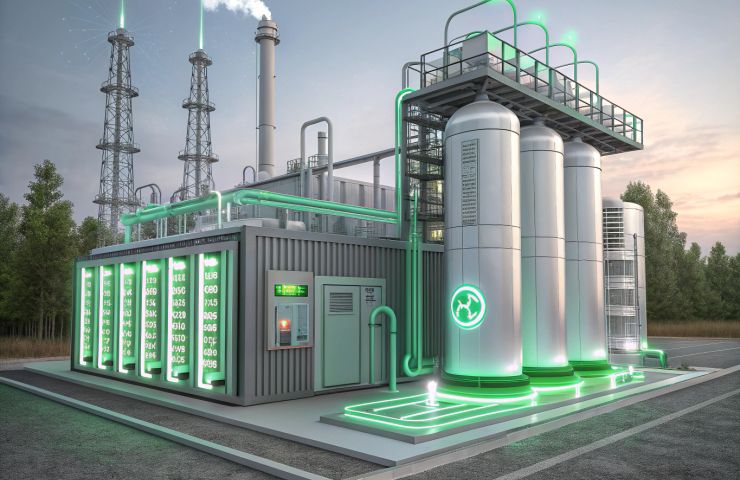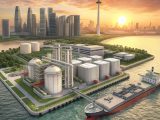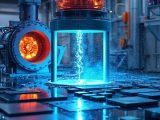
Stargate Hydrogen Unveils 10MW Electrolyser for Industrial Decarbonisation
October 8, 2025Picture a steel mill powered not by coal but by green hydrogen. That’s no sci-fi dream—it’s right around the corner thanks to Stargate Hydrogen unveiling its 10 MW electrolyser system module. This modular platform cranks out high-efficiency hydrogen production at industrial scale, complete with smart digital controls for remote monitoring and predictive maintenance. By zooming in on hard-to-abate sectors like steel, fertilizers and chemicals, this 10 MW block paves a down-to-earth path to industrial decarbonization—no need to gut existing process heat or rip up production lines. Seen as a linchpin in Europe’s emerging hydrogen infrastructure, Stargate’s latest leap aligns perfectly with the race toward zero-emissions technology and a more sustainable energy future.
From its base in Tallinn, Stargate Hydrogen morphed from a scrappy R&D outfit into a near-commercial powerhouse after snagging €11 million in Series A funding last year. Today, over 65 seasoned engineers—many no strangers to energy giants and Fortune 500 manufacturers—man the controls of a 140 MW hydrogen production line, with robotic assembly cells and ISO-certified quality checks on the roadmap. Live demos are already up and running: a wind-hydrogen pilot in the Baltics and Nordics, fertilizer plants in Turkey, a cement site down in southern Europe—and even trials in India, where harsh grid conditions put the tech through its paces. Teaming up with utilities like Fortum, finance whizzes at Rockfin and research gurus at Fraunhofer IFAM, Stargate blends academic know-how with industrial muscle.
Inside the 10MW Electrolyser
Here’s where it gets really interesting: at its core, the 10 MW electrolyser sports an advanced modular stack design powered by the Stardust Ceramic Catalyst. Unlike conventional alkaline electrolysers that lean on nickel or scarce precious metals, this ceramic marvel dodges supply-chain headaches and trims material costs by up to 30 percent. Cranking out pressures up to 32 bar, it hits efficiencies north of 75 percent lower heating value (LHV) and can moonlight as a virtual power plant, lending a hand with grid balancing. A web of onboard sensors feeds every performance tweak into a digital twin, giving operators real-time optimization and remote diagnostics. Early endurance trials by Fraunhofer IFAM are promising: thousands of cycles with only minimal degradation and steady current densities above 400 mA/cm².
Modular Design & Dynamic Integration
Stargate’s “Gateway Series” architecture lets you dial in anywhere from 1 to 10 MW of electrolysis without breaking a sweat. Plug-and-play racks snap into place, hot-swappable to cut downtime, and can ramp up or down in seconds—ideal for pairing with intermittent renewables like solar farms, wind parks or hydro plants. A built-in SCADA interface automates energy rebalancing, while machine-learning–driven remote monitoring flags any quirks before they spiral. The upshot? Operators spend less time troubleshooting and more time focusing on their core process, all while getting the most out of their green hydrogen setup.
Strategic Growth and Market Outlook
Timing couldn’t be better. Under the EU’s Fit-for-55 strategy, demand for green hydrogen is forecast to exceed 10 million tonnes by 2030, with industrial decarbonization leading the charge. Stargate’s €11 million Series A round—backed by top VCs and corporate investors—speaks volumes about confidence in its approach. Licensing talks are heating up in Central Europe, and pilot contracts are in the works in India and Turkey, where sustainable energy subsidies are on the rise. The goal? Drive the levelized cost of hydrogen (LCOH) below €2/kg by 2027—enough to tip the scales away from grey hydrogen and fossil-based ammonia.
To keep pace with this ambitious roadmap, Stargate is supercharging its Tallinn facility with extra assembly lines, robotic stack-press cells and state-of-the-art quality labs aiming for ISO 9001 and ISO 14001. Production is set to hover around 140 MW a year, with gigafactory blueprints ready for when orders hit the gigawatt scale. Over in EU-sponsored projects like EXSOTHyC and ENDURE, R&D teams are fine-tuning electrode coatings, dialing in water-management tweaks and slicing time-to-market. All of this meshes with customer co-development programs, so each system gets tailored to local process footprints, safety norms and hydrogen infrastructure plans.
Regional and EU Context
Tallinn has reinvented itself from an oil-shale bootstrapped economy into a sustainable energy hotbed. Thanks to EU investments in hydrogen valleys and cross-border corridors, the Baltics are now key players in decentralized energy networks. Brussels is pouring cash into everything from electrolyzers to storage caverns and tweaking regulations to make hydrogen infrastructure more plug-and-play. That climate of support gives players like Stargate fertile ground to grow, creating local jobs and helping Europe break free from fossil fuel imports in a volatile geopolitical landscape.
Why It Matters
Let’s face it: sectors like steel, cement and chemicals can’t just swap out heavy-duty heat for electricity and call it a day. That’s where green hydrogen shines—it’s a clean fuel, a feedstock and an energy storage medium that slots into existing gear. By cutting both capex and opex, modular electrolysers let medium-sized producers dive into low-carbon operations without a multi-million-euro leap of faith. And don’t forget: scalable hydrogen production unlocks green ammonia as a carbon-free carrier, bridging the gap between where hydrogen is made and where it’s used, from shipping to remote off-grid power.
So, what’s next? The real proof will come when these 10 MW beasts tackle grid hiccups, handle sketchy water quality and deal with shifting loads over months—or years—of real-world use. Toss in policy tailwinds like carbon border adjustments, renewable energy credits and industry decarbonization mandates, and adoption could really take off. If Stargate Hydrogen keeps pushing the envelope on catalyst tech, digital services and strategic partnerships, we might be staring at a game-changing shift: heavy industries waving goodbye to grey hydrogen and rolling out greener alternatives, one modular block at a time.



 With over 15 years of reporting hydrogen news, we are your premier source for the latest updates and insights in hydrogen and renewable energy.
With over 15 years of reporting hydrogen news, we are your premier source for the latest updates and insights in hydrogen and renewable energy.